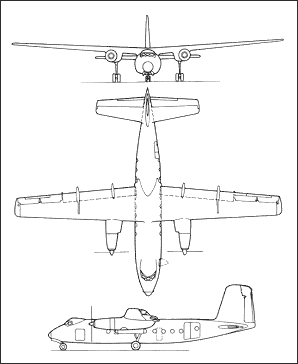|
| The prototype Dart-engined Herald made its first flight on 11 March 1958 and the first production Herald Series 100 flew on 30 October 1959. The Series 100 accommodated between 38 and 47 passengers. The Series 200 was the main production version with a forward fuselage 1.07m longer than that of the Series 100. Accommodation was provided for 50-56 passengers.
The Series 300 (a modified Series 200 developed to meet US airworthiness requirements) was followed by the Series 400 military transport with a side loading door and accommodation for 50 troops, paratroops, 24 stretchers or freight, eight of which went to the Royal Malaysian Air Force. The projected Series 500 was followed by the Dart 532/9 turboprop-engined Series 600.
The final two versions were the Series 700 long-range version of the Series 600, accommodating up to 60 passengers or 52 passengers and baggage over 1,980km stages, and the Series 800 military version of the 700.
| MODEL | Herald Series 200 |
| CREW | 2 |
| PASSENGERS | 50-56 |
| ENGINE | 2 x Rolls-Royce Dart 527 turbo-props, 1570kW |
| WEIGHTS |
| Take-off weight | 19504 kg | 42999 lb |
| Loaded weight | 11703 kg | 25801 lb |
| DIMENSIONS |
| Wingspan | 28.88 m | 95 ft 9 in |
| Length | 23.01 m | 76 ft 6 in |
| Height | 7.34 m | 24 ft 1 in |
| Wing area | 82.31 m2 | 885.98 sq ft |
| PERFORMANCE |
| Max. speed | 495 km/h | 308 mph |
| Cruise speed | 445 km/h | 277 mph |
| Ceiling | 8500 m | 27900 ft |
| Range w/max payload | 1786 km | 1110 miles |
| John Buscombe, e-mail, 06.08.2014 22:59 Flew British Island Herald to Le Borguet from Southampton. Strangely the 2 smokers were on the left side and the 15 non-smokers on the right. Therefore flight at a strange list all the way to France reply | | nestor raul meneses vargas, e-mail, 14.01.2014 05:28 Siempre me a llamado la atencion este gran avion yo trabaje con lineas aereas la urraca la cual tenia en su flota estas aeronaves como fueron el hk 715 718 y elhk721 exelentes aviones reply | | Ken McColm, e-mail, 17.06.2013 07:37 I served as an apprentice at Handley Page Reading, 1952 - 1958 in the sheet metal shop. I have crawled all over the HP3 and helped to wheel the skins and fairings, the first two with Leonides in fact and the modifications to the Dart engines. When I finished my time it was National Service, I never went back to sheet metal work. reply | | Pete Simpson, e-mail, 10.06.2012 20:37 Hi, I helped make the navigation tables for the Malasian Heralds while I was an apprentice at Cricklewood reply | |
| | Neil, e-mail, 21.08.2011 12:11 I flew the Herald in the mid 1970's for 1200 hours. I thought is was very pleasant to fly. Strong and had good handling feel compared to the DC3 which felt that the ailerons were attached with glue. During training we would go to a strip of land just south of Jersey which at low tide looked like a runway. Bad weather circuits at 200 feet were good fun, let us see what the aircraft could do and increased our confidence. Passengers seemed to like it as well. reply | | Barry, 21.02.2011 17:25 The RAF originally selected this as a transport in preference to the Avro (HS)748. However, because Sir Frederick Handley Page would not unite his company with either Hawker Siddley or BAC the goverment decided to "punish" him by not awarding his company any contracts. So that was really the writing on the wall for this once great company and eventually it disappeared altogether. It really is good the way politicians support industry in this country isn't it? reply | | luiz cauduro, e-mail, 14.09.2010 07:40 sou aeronauta e este equipamento fez parte da minha infacia. voei muito pela Sadia quando menino.unica cia.brasileira que operava este equipamento. reply | | Ken Watkins, e-mail, 25.06.2007 21:05 Congratulations on your excellent website, which I've just discovered today!
From 1954 to 1955 I worked as a stressman for Handley Page (Reading) on the wing of the Herald. You might like to add to the history of this aircraft that it was conceived as a Dakota replacement (as was its competitor the Fokker Friendship). Initially it was to have four Alvis Leonides engines, but Rolls-Royce developed the Dart (for the Vickers Viscount) so successfully that the design became the one you show. reply |
|
Do you have any comments?
|
| 
COMPANY
PROFILE
All the World's Rotorcraft
|







